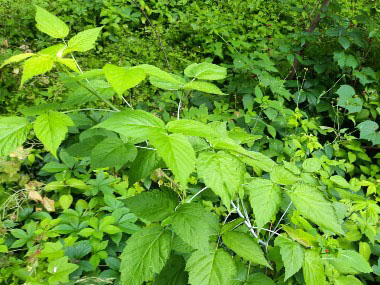






To support our efforts please browse our store (books with medicinal info, etc.).
Black raspberry is a perennial shrub in the rose family. The flowers of black raspberry are not very showy but the fruit has an excellent flavour and is rather colourful. This shrub produces arching canes, up to 2 metres (6') long, that usually live for two years. The first year, they may root at the tip if they touch ground. There is little branching. The canes are green initially, then develop a purplish-red colour, usually with a white bloom, and hooked prickles. The genus name Rubus is the Latin name for bramble and occidentalis refers to western, that is, the black raspberry of the western world. This is native to the United States and Canada. This can be easily confused with the blackberry. Blackberry stems have ridges and angles while the black raspberry stems are smoothly round-shaped, nearly circular in diametre. Also, the receptacle is removed from the raspberry when picked whereas the blackberry, the receptable is part of the fruit.
Trunk/Bark
There is no trunk or bark only leaf stalks. These are mostly smooth with a few straight to recurved barbs (or prickles). At the base of the compound leaf stalk is a pair of stipules about 1/2 cm (1/4") long. Stems can get to up to over 3 metres long (9'), covered with a waxy bloom and scattered, very sharp prickles that are straight to slightly curved or angled downward. Stems arch and root at the tips. New canes are light green to blue-green, second year canes (floricanes) produce the flowering branches and are often reddish, the canes dying before the third year but new canes emerging from the rooted tips.
Branches/Twigs
There are no branches or twigs, only leaf stalks.
Height
Black raspberry bushes are not that tall as the stems arch. They can arch at about 1 metre (3') in height.
Leaves/Needles
Leaves are alternate and compound are are typically trifoliate, rarely 5 leaves. Leaflets are egg-shaped to elliptic, mostly widest below the middle, the center leaflet long stalked, the lateral leaflets stalkless and occasionally shallowly lobed, typically 5 to 10 cm (2 to 4") long, 3 to 7cm (1¼ to 3") wide, sometimes larger, with a long taper to a slender, pointed tip and rounded to heart-shaped at the base. Edges are coarsely double-toothed, upper surface is medium to dark green, mostly smooth, the lower surface silvery and densely hairy.
Flowers
Clusters of 5 to 15 flowers at tips of lateral branches on 1-year-old stems. Flowers are white, about 1cm (1/2") across with 5 oblong to narrowly spatula-shaped petals that are initially erect, becoming ascending to widely spreading. In the center is a cluster of many styles surrounded by a ring of numerous white stamens. Alternating with the petals are 5 sepals, broadly triangular tapered to a long, tail-like tip, longer than the petals, widely spreading to curved downward, pale green to gray-green, the outer surface covered in soft, non-glandular hairs. Flower stalks are hairless to short-hairy, with scattered broad-based, cat-claw-like prickles.
Fruit
The fruit is round cluster, about half a centimetre (1/2") in diameter of fleshy druplets. When ripe is becomes purplish-black when ripe. They tend to need a slight pull to free it from the receptacle.
Habitat
Black raspberries like part shade, with some sun (open woods) and woodland edges. It prefers moist to dry soil. Many people cultivate this shrub in their gardens.
Edible Parts
The ripe flavourful fruit and leaves are edible.
Other Name
Raspberry.
Winter Survival Food Handbook

PDF Plant Magazines
Types of Wild Food
Geographic Zones Seasons
Disclaimer
EdibleWildFood.com is informational in nature. While we strive to be 100% accurate, it is solely up to the reader to ensure proper plant identification. Some wild plants are poisonous or can have serious adverse health effects.
We are not health professionals, medical doctors, nor are we nutritionists. It is up to the reader to verify nutritional information and health benefits with qualified professionals for all edible plants listed in this web site. Please click here for more information.
Why Edible Wild Food?
- Food costs are rising
- Free, wild food is readily abundant
- Wild food adds nutrition to your diet
- Wild food can help treat various medical conditions





